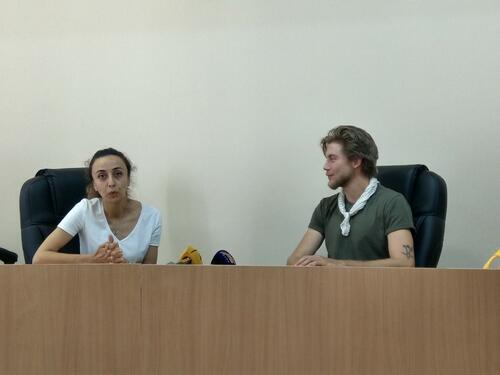In South Ossetia continues the work on engineering development of the state border with Georgia. On the progress of work, the purpose of the security barrier on the border, as well as the challenges of working in its arrangement in the interview with IA «RES» told first Deputy Chairman of the KGB of South Ossetia, the head of the Border Service of the KGB of South Ossetia, Major General Sergey Kolbin.
- Mr. Kolbin, please, tell us, what principles do you adhere to define the frontier?
- The state border of the Republic of South Ossetia under the Constitution is defined within the boundaries of the former South Ossetian Autonomous Region as part of the GSSR. Now it is developed unilaterally according to the Soviet maps. These documents underlie the definition of the border line of the state border on the ground, the organization of its protection and improvement.
- How many kilometers of the boundary are already developed, what are the barrage constructions and what is their purpose?
- To date the length of the engineering structures along the state border is 60 kilometers and they are mainly informational and preventive. It is a modern chain-link fence, which is clearly visible, and eliminates random access of people and domestic animals to the neighboring territory, both from the Georgian and South Ossetian territory. By installing the fence by the end of the last year it was reduced the number of violations of the state border by residents of the border area, who had been crossing the border line for household purposes. First of all, the fence is installed in those areas where are recorded the most frequent violations. For example, in the mountain- woodland terrain in the eastern part of Leningor district, where the boundary extends from north to south, there is no need in fence. There can be used other technical facilities. In the western sector - towards the settlements of Kvaisa, Perev, Karzman there is a similar situation. On the southern boundary, in close proximity to the Georgian settlements, there is a need to put up a fence. How long it will take is hard to say, but the work will continue.
- Who are directly involved in the provision of engineering facilities of the border?
- In 2013, the Government of the Republic of South Ossetia signed an agreement with the Russian firm "Stilsoft." Currently the contractor fenced the territory in the plains of Tskhinval, Leningor and Znaur districts. In the current year the work on development of the state border will be continued. Strategy for strengthening the state border will continue in engineering terms, as well as in terms of increased density and reliability of its protection. This implies the introduction of modern technical means, including video surveillance, radar, thermal imaging cameras and projectors, which will facilitate the monitoring, timely detection and securely fix the facts of violations and crimes. This will create favorable conditions to prevent violation of the state border. In addition to the financial component, this process requires more time. This process will be gradual, with the participation of Russian border guards, who, in accordance with our proposals, provide technical support to protect the state border.
- Whether the border line passes through the residential settlements?
- The boundary passes not only through uninhabited areas, but also through human settlements. The border guards have to face situations where the boundary divides not only any human settlement, but also courtyards and plots of land. We try to find a compromise to settle this question. Today, there are cases where property of the residents of the border villages is divided by the border line. There are a few cases when the whole house is across the frontier on the territory of Georgia. But when we start a dialogue with the neighbouring country, these issues will be much more. Because, to define the administrative border line on the map, we try to bring a barrage line so that it does not affect the population. In Georgia, there is a lot of talk about that by erection of engineering structures are violated the rights of citizens of Georgia. It may sound a bit rough, but citizens of Georgia do not interest us. This is a problem of the Georgian side. Georgia must find the way to compensate its citizens the losses of those lands, which remained on the territory of South Ossetia. We also face the situations where the land cultivated by our citizens turned out to be in the territory of Georgia.
- How residents of these human settlements take this unexpected division of their "own territory"?
- This issue also causes a negative reaction of the inhabitants of our frontier settlements. In turn, we try to explain to the population the whole situation, often finding the understanding, sometimes not. It works as a purely human factor, when our citizens ask why the alleged "native Ossetian land" remains on the territory of Georgia, outside the fence. Here it is necessary to divide the household approach of citizens and the state approach. When our citizens say that the "native Ossetian land" remains on the other side of the barrier fence, they mean the times when there was no a state border line, and nobody raised the issue to erect barriers to cultivate lands. Quite natural that our citizens could cultivate the plots of land outside the South Ossetian Autonomous Oblast, grazed cattle there, engaged in other economic activity, as well as residents of the Georgian villages in our territory. Now the situation has changed. The once existed administrative boundary has acquired the status of a state. Accordingly have changed approaches to this demarcation line. All aspects related to the negative attitude of the people living in the border area, are used by our ideological enemy which continues to play up these issues. First of all, in Georgia are raised questions on problems of its citizens, incidentally mentioning problems of Ossetian citizens, but more often they prefer to keep silent about the problems of the residents of the Ossetian border areas. In the area of the settlement of the Georgian Dhwani, the border line runs directly on the outskirts of the village. Three houses of Georgian citizens - or rather, the ruins turned out to be in our territory that is practically on the territory of our village. Georgia decided to resettle its citizens. They disassembled the ruins of the houses, the people at the moment didn`t live there. In the South Ossetian village of Tsnelis in Znaur district, where the border line runs along the river Lopan, several residential houses turned out to be on the right bank of the river, in the territory of Georgia. In former times it was impossible from Georgia to drive up to these houses on the right bank of the river- only from South Ossetia. But if we consider the border of South Ossetian Autonomous Region and Georgia, that part of the village on the right bank has remained on the territory of Georgia. Today, the inhabitants of this settlement are in a quandary, because to travel to Georgia, they need to cross the territory of South Ossetia. However, those citizens who live on the right bank of the river obtained permit to build houses not in South Ossetia but in the Gori district administration. In fact, they are citizens of Georgia and registered as citizens of Georgia. And the fact that they are integrated into the South Ossetian society and in the life of South Ossetia is a little different situation. Here is an example, when the border line has divided one village into two parts.
- How in your opinion can be resolved these issues?
- In the case of bilateral discussions, it may be possible to resolve the transfer of the plots of land and houses separated by the state border line to the residents on advantageous terms. Crossing the border - is a process of bilateral recognition and mutual agreements. The state border will pass, where it will be defined bilaterally by South Ossetia and Georgia, after the joint delimitation and signing the agreement. If Georgia gets down to negotiations, and instead of the desired territory, will be ready to transfer its plots of land and structures in the interests of the parties, it will be so. If the official Tbilisi, as now, shies away from discussing the border line, we will have to keep it as it is marked on the map. It is very painful and unpleasant, but, unfortunately, it is quite a common situation where there is a division between states.






